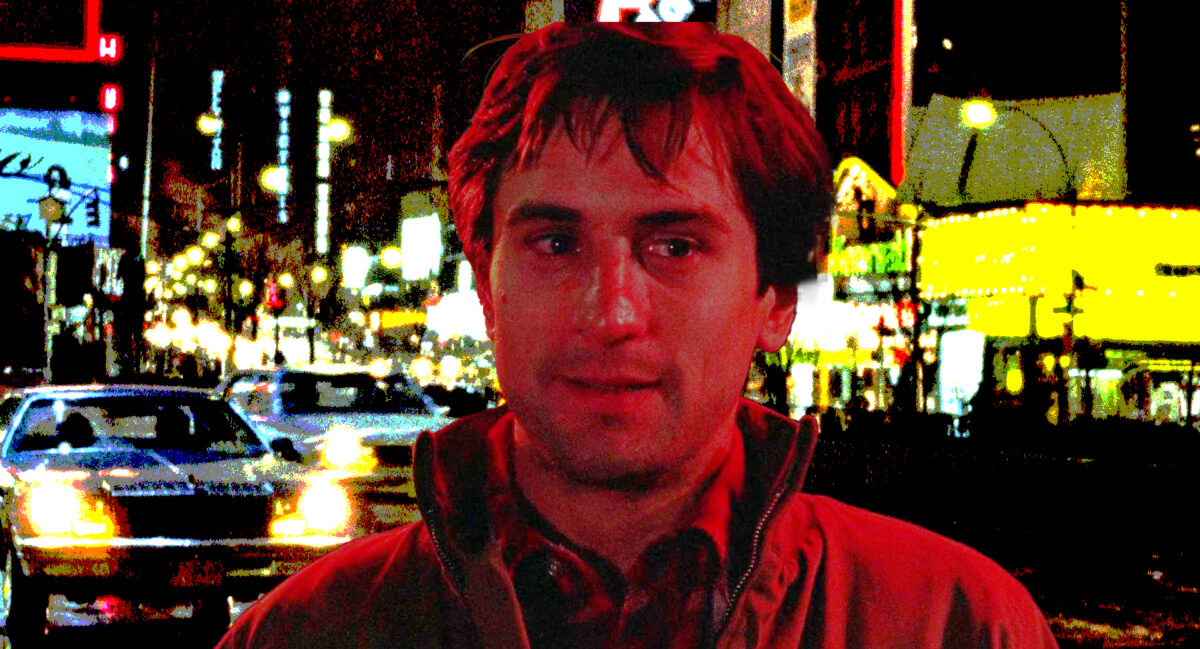Martin Scorsese’s 1976 thriller sees jazz music used as a resurrector of ghosts both good and bad. (Source Photo: Robert De Niro in “Taxi Driver,” via IMDB)
SAMUEL HYLAND
One of the most harrowing scenes in Martin Scorsese’s landmark psychological thriller Taxi Driver (1976) sees titular character Travis Bickle, an enigmatic Vietnam War vet played by Robert De Niro, seek counsel in “Wizard,” his older and wiser professional peer, about an increasingly violent impulse burgeoning from long days spent in New York’s inner-city squalor. The moment is bathed in blood-red fluorescent light, dually evocative of the hellish nature of Manhattan’s underbelly and an eerily-prophetic glint of Bickle’s fate; the two characters, ghastly in the crimson fog, register more as entities locked into a tense spiritual transaction than cabbies engaged in late-night conversation. “Sometimes it gets so I just don’t know what I’m gonna do,” Bickle admits, distant and out-of-kilter. “I get some real crazy ideas, you know? Just go out and do something.” Wizard, who has been driving taxis for nearly three decades, passes it off as the inevitable bout of seasonal depression that comes with the job. “Travis, look, I dig it. Let me explain. You choose a certain way of life. You live it. It becomes what you are,” he retorts. “Look, a person does a certain thing and that’s all there is to it. It becomes what he is. Why fight it?”
“It’s an endlessly oscillating descent of power chords, both foregrounding and foreshadowing an endlessly oscillating descent of mind for the man it serenades.”
Moments after Wizard assures him that he’s alright, Bickle watches his co-worker—and ostensible last shot at sanity—duck into the driver’s seat of his taxi and roll off into the distance. He remains standing on the sidewalk for an unsettlingly long time, and as we see him looking on through the rearview mirror of Bickle’s vehicle, the orchestral sonic angst of Bernard Herrmann fades in. The number is pointedly reminiscent of a sort of ghastly funeral procession, characterized by monotone organs and a faint cymbal that operates as a dying heartbeat. It wears on as the film cuts to a close-up of Bickle’s television screen, broadcasting a public address by Presidential candidate Charles Palantine—the candidate-of-choice for Betsy (last name unknown), a Palantine campaign worker who has just broken up with Bickle after date-night-gone-wrong in a porn theater—and we see flashes of intensity in his eyes as he stares down the blue light. Both the song’s slow-churning ethos and musical structure contribute to a sense of cognitive horror: it’s an endlessly oscillating descent of power chords, both foregrounding and foreshadowing an endlessly oscillating descent of mind for the man it serenades.

Taxi Driver’s premise is rooted in a disillusioned war vet looking for evening work as a cabbie because he “can’t sleep nights” anyway. From the very first time we see his angry eyes in the rearview, De Niro’s Travis Bickle is radically alone, incompatible with any and all human contact aside from the few ways he’s able to connect with himself—a set of distant aphorisms he writes down in a notebook, and, more prevalently, an eerie narration practice that sees him stammer through his darkest moments, his voice a wobbly flashlight down the pitch-black crevices of his twisted machinations. Requisitely, there’s also his addiction to the pornographic theater frequented by his fellow loners on 42nd Street; the film opens with him sunken into his velvet chair there, and in the last glimpse we see of him in that X-rated cinema, he’s ominously pointing a finger gun at the screen.
Early on, Bickle becomes infatuated with Betsy, the aforementioned campaign worker for Palantine’s Presidential bid, and woos her with an on-the-spot romantic proposition—much to the dismay of Tom, an annoyingly jittery fellow campaigner played by the comedian Albert Brooks. The unlikely pair—an out-of-touch loner who knows nothing about politics, and a witty, well-to-do blonde woman who devotes her career to getting someone elected—are somehow mutually attracted, until the aforementioned porn-date debacle marrs their connection, and an enraged Bickle storms Betsy’s workplace before being physically forced out of the office by Tom. At a later point in the film, our increasingly-deranged protagonist coldly places a bouquet of flowers he had purchased for Betsy in his sink, and lights them on fire.
“Somber orchestral compositions play in the background as bloody murder is machinated; ritzy blonde campaign workers occupy the same restaurant tables as rugged, porn-addicted Vietnam vets; on the very same sidewalk that a 12 year-old prostitute is being solicited by an older man in broad daylight, young, oblivious children are running past their peer, far from the faintest idea of what’s about to happen to her.”
Exacerbated by both the heartbreak of his split with Betsy, and the squalid torrents of New York City’s darkest hours, Bickle’s madness intensifies. In one disturbing scene, Scorsese sheds his directorial cloak to portray a hostile passenger, seething with rage, who forcefully instructs Bickle to stop at an apartment wherein his wife is cheating on him with a black man. He points to the exact window his wife is in, then goes into unsolicited detail about what he intends on doing upon exiting the vehicle: “I’m gonna kill her with a .44 Magnum pistol.” The camera returns to the seventh floor window, in which the shadow of a woman is readying itself between puffs on a cigarette. “Did you ever see what a .44 can do to a woman’s face, cabbie?” There is an uncomfortable pause. Scorsese’s character doubles down. “Did you ever see what it can do to a woman’s pussy, cabbie?” As Bickle remains silent, wallowing in his familiar-yet-strange distance while the man in the backseat repeatedly asks him whether “you think I’m sick, huh?”, there is the notion that in his inhumanity, he also inadvertently allows people to see themselves. It’s a dynamic moment when, in the midst of being verbally abused by his murderous passenger, he tilts the mirror so that the man can witness his own furor. It feels as if by tilting the mirror, Bickle has also altered the question’s path of reverberation across the insides of the car: now, instead of chastising Bickle, the man finds himself chastising a reflection—I think I’m sick, huh? There is another uncomfortable pause. The man chuckles, the scene cuts, and it is left unclear whether a murder was committed that night or not.
In a happier point of Bickle’s character arc prior to this—while he was still lovestruck with Betsy—there was an instance where he had coincidentally picked up Palantine, and was asked by the candidate what bothered him most about America. After initially deflecting the question with the excuse that he wasn’t knowledgeable on politics, he settled on the filth of the city: “It’s full of filth and scum,” he rambled. “Scum and filth. It’s like an open sewer. I can hardly take it. Some days I go out and smell it then I get headaches that just stay and never go away. We need a President that would clean up this whole mess. Flush it out.”
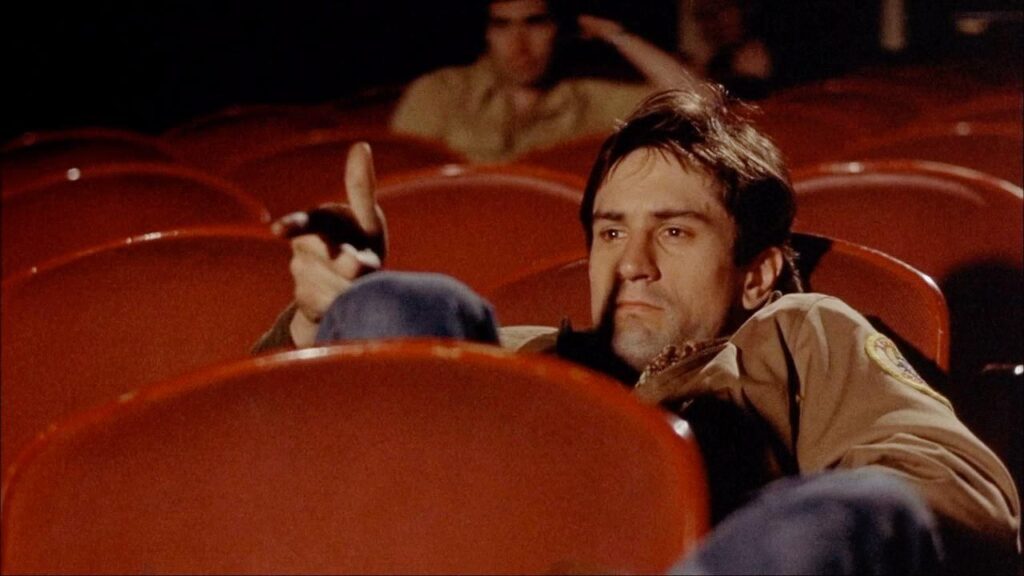
As the film draws on, it becomes evermore apparent that Bickle himself wants to be the savior that rids New York of its filth—both moral and physical. He becomes aware of a child prostitution operation that rages on after dark, and purchases four handguns from a seller introduced to him by a fellow cab driver. The movie begins to focus on an increasingly violent physical training regimen he adopts as a distraction from his gutted conscience, and sooner than later, we see typical exercises turn into intense practice runs of drawing weapons from hidden crevices of his jacket and pants. After a ruse to assassinate Palantine is squandered when a security guard catches him drawing his gun, Bickle confronts the pimp of a 12 year-old prostitute he’s become infatuated with, and shoots him in the stomach. A bloodbath ensues inside the brothel, and he winds up killing everyone involved—the girl’s clients, the bouncer, and the pimp—before falling into a coma himself. By film’s end, we are made aware of the fact that he has managed to not only survive, but avoid jail time and be heralded as a national hero.
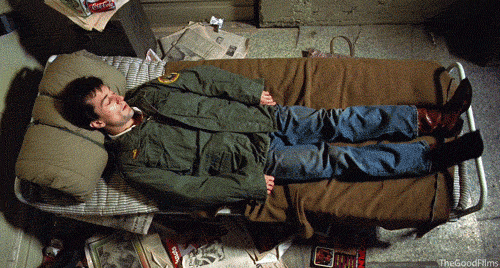
The narrative is a wicked portrayal of an equally-wicked urban infrastructure, complete with contradiction after contradiction: somber orchestral compositions play in the background as bloody murder is machinated; ritzy blonde campaign workers occupy the same restaurant tables as rugged, porn-addicted Vietnam vets; on the very same sidewalk that a 12 year-old prostitute is being solicited by an older man in broad daylight, young, oblivious children are running past their peer, far from the faintest idea of what’s about to happen to her. “This New York is a voluptuous enemy,” former New Yorker writer Pauline Kael wrote in a 1976 review. “The street vapors become ghostly; Sport the pimp romancing his baby whore leads her in a hypnotic dance; the porno theatres are like mortuaries; the congested traffic is macabre. And this Hell is always in movement.”
For a film that, in effect, chronicles a man’s descent into madness in the depths of the underworld, the title “Taxi Driver” somewhat strikes one as succinct. The least of the many titles Travis Bickle occupies is “taxi driver”—he’s simultaneously a murderous psycho and a U.S hero, an almost-assassin and the most genuine man roaming the most unforgiving streets. But no matter what he does in the film, his occupational label hangs over him like the blood-red light that saturated his late-night talk with Wizard. That evening, Wizard told him that once he was a taxi driver, he was destined to be that forever. And though Bickle doesn’t die by the movie’s end, you feel that whatever version of him existed before the soulless vigilante certainly has—the depths of New York City serve as an afterlife of their own, and he’s stuck there for as long as he can survive before graduating on to the real Hell that burns below.
🌐 🌐 🌐
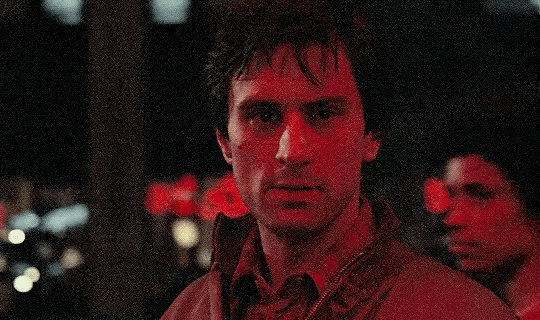
The first in-depth look we get into Travis Bickle’s conscience comes when, a scene after he lands the job as a taxi driver, he chillingly narrates his way through what those nightly escapades entail. “I go all over. I take people to the Bronx, Brooklyn, I take them to Harlem, I don’t care,” he starts, soullessly eschewing the slightest change in tonality. “Don’t make no difference to me. Does to some. Some won’t even take spooks. Don’t make no difference to me.”
As the words stumble uniformly out of his mouth, another jazz composition by Herrmann rages on in the background—it treks up to violent, jagged, cymbal-clattering crescendos, threads between the somber and monstrous tied together by hauntingly vague bass notes. You begin to feel a palpable air of unsettlement, one that lasts throughout the film; if Bickle’s eyes aren’t already doing it, the music is screaming bloody murder, and without anything explicitly saying so, it is suddenly completely practical for Travis to lash out and strangle a passenger to death at any given point. This particular Herrmann score has long faded out when we are introduced to the snobbish nature of his first passengers (a raunchy old couple that can’t stop talking about sex—Bickle goes on to narrate that he sometimes has to “clean the cum off the back seat”). But by the time the man opens his mouth, we are already subconsciously not only preparing for, but justifying, the blowing out of his brains.
“Acid rock was making disorientation a sonic, palpable experience; new drugs were collaborating with new instruments to invent new highs; America’s ideological security blanket had long been stripped away, and the sonic soundscape, too, was now beginning to shiver.”
On a macro level, the entire soundtrack of Taxi Driver, curated by Shinichi Yamazaki, plays the essentially the same role as the indistinct bass notes backing Bickle’s opening monologue: where the crescendos are our protagonist’s violent outbursts and on-the-edge aura, Herrmann’s music is a somber harbinger, a stand-in that doesn’t always match its subject’s fury, but nevertheless constantly transports it from notch to notch. Why, though, one must ask, was this—the stuff of a Frankenstein-esque, mom-and-pop horror film era that had long let out its final breath—enlisted, let alone considered, to be the missing puzzle piece in a high-flying psychological thriller of Taxi Driver’s ethos? “It’s clear why Scorsese wanted Herrmann: his specialty was expressing psychological disorder through dissonant, wrought-up music,” Kael wrote. “But this movie, with its suppressed sex and suppressed violence, is already pitched so high that it doesn’t need ominous percussion, snake rattles, and rippling scales. These musical nudges belong back with the rampaging thrillers that ‘Taxi Driver’ transcends.”
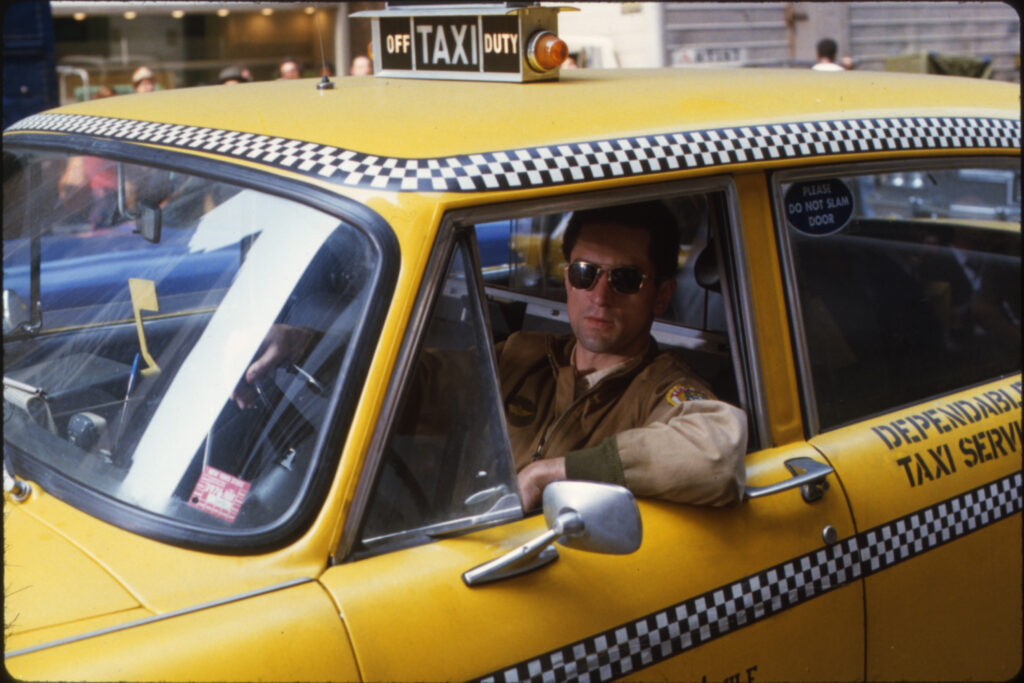
The question becomes one of what Scorsese’s screenplay does need musically, if anything at all. Taxi Driver came to theaters in the thick of a post-Vietnam cultural hotbed that bred inherently anxious musical innovations—acid rock was making disorientation a sonic, palpable experience; new drugs were collaborating with new instruments to invent new highs; America’s ideological security blanket had long been stripped away, and the sonic soundscape, too, was now beginning to shiver. There is an expansive host of rhythmic channels Yamazaki could have engaged to not only match the horrors of Scorsese’s hellish New York, but enliven the hellfire with a palpable, cathartic char. Take the moment in which a desperate Bickle confides in Wizard, the last iteration of anything close to sanity we’ll see in him for the remainder of the film: had the dreary, trudge-along atmosphere of Herrmann’s orchestra been replaced with something like Led Zeppelin’s “In My Time of Dying”—a harrowing, psychedelically twisted death song wherein the guitars are just as spectral as the words—how much differently would it strike a viewer to watch Bickle wave his right mind goodbye behind instrumentation that shared his electric madness? Or, take another look at our first glimpse of Bickle’s internal machinations, where he nonchalantly narrates a sordid trip down Manhattan’s late-night rabbit-hole. Had Hermann’s Frankenstein-channeling suspense been substituted for by something like the midpoint of Black Sabbath’s “Electric Funeral,” wherein Tony Iommi’s choky Gibson SG plunges into guttural, three-chord descents amidst the breakneck drumming of Bill Ward, just how much more headspace would Bickle’s raging monstrosity demand in the film’s opening minutes alone? With Hermann’s numbers, Travis Bickle is just a monstrous human. With the music that soundtracked Taxi Driver’s cultural era, Travis Bickle could have become a humanistic monster.
“And much like the Manhattan that stood in for what real Hell that likely awaited him, this, too, Travis Bickle could not escape.”
But the unshakable appeal of muted jazz music for a movie about New York City’s violent underbelly is, regardless of cultural shifts, yet one more longstanding contradiction latched to the history of a landscape defined by them. Jazz music commands a certain permanent mythology across the sidewalks of Manhattan, where, whether it was blasting through the doorways of black clubs in the early 1900s, haunting the hip-hop samples emanating from boomboxes on street corners during rap’s birth several decades later, or saturating the morbidity of the subway for panhandled cash all throughout, it never left the infrastructure, even when popular culture had long seemed to transcend its original glimmer. Early on in his autobiography, Malcolm X recalled witnessing jazz’s first-generation stranglehold on Harlem firsthand, from the glistening floors of the Savoy Ballroom to the sweat-drenched confines of the Lenox Club. “Then, early in the 1920’s music and entertainment sprang up as an industry in Harlem, supported by downtown whites who poured uptown every night,” he wrote. “(…) And at four A.M., when all the legitimate clubs had to close, from all over town the white and Negro musicians would come to some prearranged Harlem after-hours spot and have thirty-and forty-piece jam sessions that would last into the next day.”
Those early 20th Century days saw the genre represent one of few benevolent threads bridging gaps between New York’s otherwise-alienated disparate cultural identities; where Manhattan’s black and white populations increasingly saw their paths intersect via racialized fetishization, interwoven gang activity and otherwise underground squalor, it became something that miraculously turned an early-morning black-white rendezvous into a non-murderous affair. Even beyond just race, the gaps jazz would serve to bridge both then and in its future were generational. In his 2019 book Go Ahead in the Rain: Notes to A Tribe Called Quest, the writer and poet Hanif Abdurraqib notes that the Queens hip-hop collective “made rap music for our parents and theirs but left the door open wide enough for anyone to sneak through. Anyone with rhythm or anyone who knew how to find it before the bass high-stepped itself across a dance floor.” He goes on to zero in on the group’s landmark single “Jazz”: “Q-Tip, in the first verse of ‘Jazz,’ sums it up evenly: ‘I don’t really mind if it’s over your head / ‘Cause the job of resurrectors is to wake up the dead.’”
Jazz music woke up the sonic dead throughout New York City, and no matter what shape its manifestation took on, it carried the ghosts of its former suitors along with it into the hereafter. Perhaps this quality is what gives it its strange, albeit misplaced, appeal in Taxi Driver: not only did jazz leave the door open for the beauty it curated in its past—think blacks and whites dancing alongside each other in the Savoy Ballroom—to transcend the early 20th Century, but it also allowed the same, lasting blackness of Manhattan’s substratum grappled with by Bickle to seep into the hellhole his conscience rotted in. Jazz was the sidewalk that saw a 12 year-old prostitute solicited while her peers played nearby in oblivion; it was the restaurant table that saw a deranged Vietnam War veteran somehow establish connection with a well-to-do office lady; it was the air in which funereal instrumental compositions occurred at the same time as violent, murdeous descents into insanity. And much like the Manhattan that stood in for what real Hell that likely awaited him, this, too, Travis Bickle could not escape.
“It’s clear why Scorsese wanted Herrmann: his specialty was expressing psychological disorder through dissonant, wrought-up music.”
The final scene of Taxi Driver sees a recovered Bickle once again on the same streets, and behind the same wheel, that commanded him at the beginning of the movie. He happens to pick up Betsy. She’s impressed by what she’s been reading about him in the papers, and seems to want to reconcile, though Bickle’s distant inhumanity remains intact—he offers faint smiles through succinct Thank Yous, and besides offering to cover for her fare, only ever gives one-word answers. When she exits the car and a grinning Bickle drives off, we see Betsy in the rearview mirror, staring us in the eye as she shrinks into the distance, the same way her once-lover did upon being told by Wizard that he would be fine underneath crimson light.
And there is a sense that this is true—that it was only seasonal depression, of which Bickle is now cured, and the future must be a peaceful one. A somber, romantic jazz number by Herrmann grows slightly louder.
As Bickle’s eyes suddenly grow murderously agitated at something in the rearview mirror, the music tenses for a split second, and the end credits begin to roll down the blood-red lights of the filthy Manhattan streets.
SW.
The new internet.

